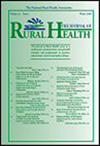Medicare telehealth utilization by Rural Health Clinics and Federally Qualified Health Centers prior to and during the COVID-19 pandemic
Abstract
Purpose
To address the extent to which Federally Qualified Health Centers (FQHCs) and independent and provider-based Rural Health Clinics (RHCs) were using telehealth prior to and during the COVID-19 pandemic.
Methods
A nationally representative 5% sample of Medicare Fee-for-Service beneficiaries who used outpatient services at FQHCs and RHCs were identified within the 2019–2021 5% Medicare Limited Data Set Outpatient and Carrier files. Rural-Urban Continuum Codes were used to identify rural–urban clinic locations. Logistic regression included three-way interaction terms for time, rurality, and clinic type.
Findings
Telehealth use curbed the decline in outpatient visits for all clinic types during the pandemic. Telehealth use declined as the pandemic continued in 2021 yet remained higher than pre-pandemic levels. FQHCs had higher telehealth use (18%–31%) than RHCs (8%–14%) in 2020–2021. Across all years, tele-behavioral health was the primary venue for originating and distant site providers. Overall, 19%–34% of originating site providers were psychiatrists and 10%–31% were primary care providers. Likely due to patients sheltering-in-place (at home), 2020–2021 distant site providers were largely primary care providers. Urban FQHCs experienced the largest increase in telehealth use during the pandemic (24.6% increase in urban, 14.4%–15.8% in rural) followed by rural ID_RHCs (10.2%–11.7%). RHCs were less likely to provide telehealth services than FQHCs during the pandemic.
Conclusions
Telehealth played a key role in facilitating access to health services during the height of the pandemic (2020–2021). Telehealth flexibilities were associated with greater telehealth use among FQHCs and RHCs but did not make up for the overall decline in health service use.

 求助内容:
求助内容: 应助结果提醒方式:
应助结果提醒方式:


